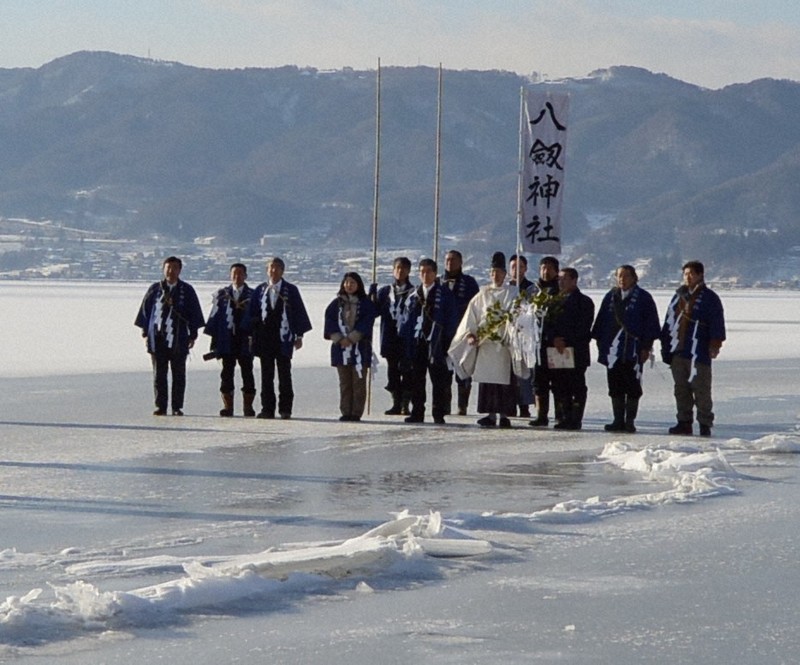
SUWA, Nagano — For the seventh consecutive winter, the natural occurrence known as "Omiwatari" has failed to materialize on Lake Suwa in Nagano Prefecture. This phenomenon involves ice formation on the lake’s surface splitting into a pattern resembling mountain ranges. Experts suggest that climate change might be contributing to this absence.
Based on records dating back to the Muromachi era (from 1336 to 1573), the frequency of winters lacking the "ake no umi" phenomenon has significantly increased since 1951. Kiyoshi Miyasaka, the 74-year-old head priest at Yatsurugi Shrine located in the city of Suwa within the prefecture, noted that "The effects of climate change and global warming are clearly visible on the lake."
It is said that according to legend, Omiwatari was the path taken by Takeminakata, the male deity of Kamisha Shrine within the Suwa Taisha shrine complex in Suwa, when he visited the goddess Yasakatome at her shrine, Shimosha Shrine, located in the nearby town of Shimosuwa. Because of this, it is often referred to as the “divine path of love.”
Miyasaka states that the Omiwatari was initially documented in 1397. These records were preserved in documents handed down through the Moriya family, who formerly led the Kamisha Shrine of Suwa Taisha. Following a temporary halt, annual documentation began again in 1443 during the middle Muromachi period, marking this as the 583rd instance of recording whether it occurred or not.
Over eight decades, from 1936 onwards—accounting for five missing years—"Ake No Umi" has taken place 81 times. Since 1951 specifically, within this 75-year span, it has happened 40 times. Notably, after the year 2000, this occurrence seems to be less frequent; out of these recent years, only 18 experienced the Omiwatari phenomenon. Importantly, it hasn’t appeared again since Japan transitioned into the Reiwa era in 2019. Concerned about this trend, Miyasaka remarked, “The traditional sights of Lake Suwa we’ve known might vanish soon. Soon enough, ‘Omiwatari’ could merely remain a legendary memory.”
This year also saw a scarcity of extremely cold days. On January 20, at a weather station located on the southern shore of the lake—a time typically considered the coldest day of the year in Japan—the thermometer read 3.2 degrees Celsius for the water temperature and zero degrees Celsius for the air. These figures matched those usually recorded around late March. Despite a frigid spell from February 9-10 causing temperatures to drop to -10°C, leading to widespread freezing across most of the lake’s surface, significant portions thawed again the following day. As forecasts did not predict additional cold fronts, officials termed this season an “akénoumi.”
On February 15th, Miyasaka announced the absence of an Omiwatari at his shrine. However, he cheerfully remarked afterwards, "Even though we didn’t have the Omiwatari this time, it’s invigorating to feel that spring has arrived."
The Ake no Umi Winters took place over the most extended consecutive duration of eight winters from 1507 to 1514, which falls within the Sengoku (Warring States) era of the late fifteenth and early sixteenth centuries. During this period, each year’s absence of Omiwatari was briefly documented in contemporary records. This prolonged sequence ranks as the second-longest; the next longest series spans six winters, occurring continuously from 1992 to 1997.
Miyasaka hypothesized that the eight-year gap occurred during the tumultuous times of war, suggesting it might not have been an appropriate moment for the ceremony. He further commented, “Considering this as the second longest interval, we should contemplate the impacts of global warming. Often, people view climate change as though it’s happening far away from them; however, we must acknowledge that even our own Lake Suwa is undergoing transformations—such changes are evident through the absence of ice cover on the lake. My wish is for everyone to reflect upon these findings.”
(Japanese original by Kazunori Miyasaka)